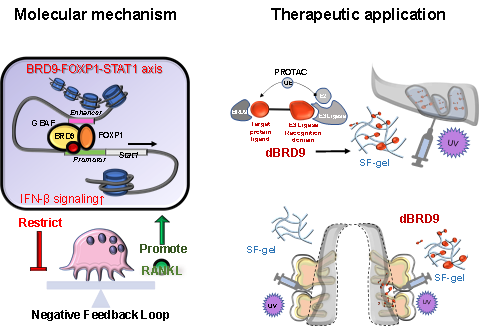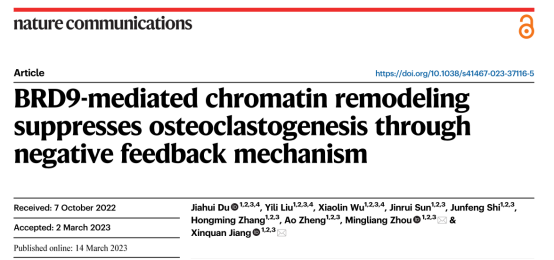The function and homeostasis of bone relies on the balanced bone remodeling process, which is a continuously cycle of bone formation mediated by osteoblasts and resorption mediated by osteoclasts throughout life. Osteoclasts are hematopoietic myeloid lineage and derived from bone marrow-derived monocytes (BMDMs). The defective osteoclast differentiation willdisturb the skeletal architecture and cause debilitating bone diseases such as osteoporosis, osteopetrosis, osteonecrosis, Paget’s disease and so on. Therefore, clarifying the molecular biological regulation mechanism of lineage differentiation during osteoclastogenesis can provide important therapeutic clues for the treatment of human bone diseases and promote bone regeneration and repair in the future.
Bromodomain-containing protein 9 (BRD9), a component of non-canonical BAF chromatin remodeling complex, has been identified as a critical therapeutic target in hematological diseases. Despite the hematopoietic origin of osteoclasts, the role of BRD9 in osteoclastogenesis and bone diseases remains unresolved. Aim at this problem, the research group of Prof. Xinquan Jiang from Department of Prosthodontics, Shanghai Ninth People’s Hospital, College of Stomatology, Shanghai Jiao Tong University, published a research article entitled "BRD9-mediated chromatin remodeling suppresses osteoclastogenesis through negative feedback mechanism" in Nature Communications (IF:17.694).

In their study, researchers showBrd9 deficiency in myeloid lineage enhances osteoclast lineage commitment and bone resorption through downregulating interferon-beta (IFN-β) signaling with released constraint on osteoclastogenesis. Notably, they show that BRD9 interacts with transcription factor FOXP1 activatingStat1 transcription and IFN-βsignaling thereafter. Besides, function specificity of BRD9 distinguished from BRD4 during osteoclastogenesis has been evaluated. Leveraging advantages of pharmacological modulation of BRD9 andflexible injectable silkfibroin hydrogel, they design a local deliver system for effectively mitigating zoledronate related osteonecrosis of the jaw and alleviating acute bone loss in lipopolysaccharide-induced localized aggressive periodontitis. Overall, these results demonstrate the function of BRD9 in osteoclastogenesis and its therapeutic potential for bone diseases.

This study was completed in Shanghai Key Laboratory of Stomatology, Shanghai Research Institute of Stomatology, Shanghai Engineering Research Center of Advanced Dental Technology and Materials.Dr. Jiahui Du, the first author of this study, graduated from Shanghai Jiao Tong University and is now a resident at the Department of Prosthodontics inShanghai Ninth People's Hospital, Shanghai Jiao Tong University School of Medicine. Dr. Du once studied at the School of Dentistry, University of Southern California in the United States. She was selected to the Shanghai Pujiang Talent Program in 2021, and was supported by the National Natural Science Youth Foundation in 2022. Dr. Du focuses on the molecular biological mechanism of epigenetic regulation of craniofacial development and regeneration. Her relevant academic achievements were published in Nature Communications, Cell Reports, Development, and Journal of Dental Research. Yili Liu, Ph.D candidate in 2022 Zhiyuan Honors Program at Shanghai Jiao Tong University School of Medicine, is co-first author of this study.
Full text link:Du, J., Liu, Y., Wu, X.et al. BRD9-mediated chromatin remodeling suppresses osteoclastogenesis through negative feedback mechanism.Nat Commun 14, 1413 (2023).https://doi.org/10.1038/s41467-023-37116-5




